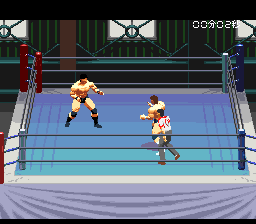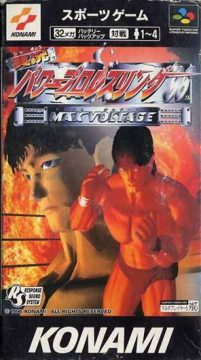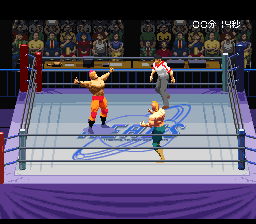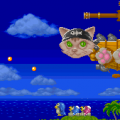After the immense success of Human Entertainment’s Fire Pro series of wrestling games in Japan, there was a flood of wrestlers for SFC from a large variety of developers. With so many other titles in the genre available for the console, designers had to do something to make theirs stand out, so the console has a pretty diverse selection of wrestling games. There are management sims, like Super Wrestle Angels, Bishoujo Wrestler Retsuden, or Joshi Pro Wrestling Story. Then there are ports of popular arcade games, like Saturday Night Slam Masters or the kind-of-wrestler-ish kaijuu themed monster battle games King of the Monsters. Yet others just simply gave their game an official license, like ZNPW, SNPW, or JWP. There were even a few that took a wrestling theme and made it into a Street Fighter II-style game, like Onita Atsushi – FMW, Saikyou – Takata Nobuhiko, or the Sougou Kakutougi Astral Bout trilogy. Others, like Gekitou Burning Pro Wrestling, tried to do the impossible and outdo Fire Pro at its own game. Konami also took a shot at the genre with the game Jikkyou Power Pro Wrestling ’96: Max Voltage.
As its title would suggest, Jikkyou Power Pro Wrestling ’96: Max Voltage was released in 1996 by Konami for SFC. It was an obvious attempt to cash-in on the immense popularity of Fire Pro, so it’s a pretty shamelessly blatant clone of that series. Still, it’s executed as such an extraordinarily high level that it’s probably the best non-Fire Pro wrestler available for the console, and it brings enough to the table that there are several reasons to play the game even if you already have the Fire Pro entries that were released for the platform.
For starters, there’s its characters. You’ve got a grand total of fifty fictional characters across four equally fictional federations. The first of the four is called Super Japan Pro Wrestling. This group has the kinds of guys that you’d find in your standard Japanese federation circa 1996, like SNPW or ZNPW. Skipping ahead, the third group is called BOM. They’re supposed to be your basic hardcore-style fed, and they’ve got some pretty over-the-top character designs. The fourth group is called REAL’S, and is comprised of mixed-martial artists/shoot fighters.
Finally, there’s the second group. This federation is called WWK – an obvious play on WWF and/or WCW. Of course you’d expect this would mean that they’re parodies of American wrestlers, but that’s not the case. Konami games are routinely chock-full of self-references, but they took it to the extreme in this case and stocked the entirety of WWK with wrestler-ified Konami characters! The sprites really just borrow the color schemes, but the character portraits on the selection screen make it pretty clear who they’re supposed to be referencing. But this aspect to the game alone should make it well worth playing for any Konami fan. Many of their names are changed, but it’s pretty obvious who’s who if you get the references.
There’s Bill and Lance from Contra, Goemon, Getsu Fūma from Getsu Fūma Den, Richter Belmont, that guy from Meikyuu Jiin Dababa, a Snatcher, and that guy from Battlantis. There’s also a character from Yie Ar Kung-Fu, but it doesn’t do anything to specify whether it’s Oolong or Lee Young. I would guess that it’s Lee, but that’s strictly because he lacks a shirt. Strangely enough, the non-human characters that have been humanized. Appearing, in human form, are Moai Head, Blue Option, Pink Option, Vic Viper, and Lord British (all from Gradius / Salamander), and even Sparkster. Also, that Battlantis guy (called Spel Attlantis here) and Sparkster are obvious tributes to Spel Delfin and Hulk Hogan, respectively.
The gameplay is a bit tough to figure out. What you need to learn first is that grapples are based on timing. To initiate a grapple, just push X. This will cause your character to lunge at your opponent. If they collide then they will enter into a grapple, and you will have to enter a command for your move as quickly as possible after the EXACT right frame of animation, but without being early. Immediately after the characters hit the frame that’s shown in the grappling timing example, beads of “sweat” (or something?) will fly up in the air.
If you’re quicker to do this than your opponent is, without being too early, then you’ll execute your attack. Rather than being able to perform any move at any time, you can only access lower powered grappling moves at the beginning of a match, and you gain access to stronger grappling attacks after your opponent has accumulated damage. Just push Y for low-powered moves, B for mid-powered attacks, and A for high-powered maneuvers. Your arsenal is made much larger by allowing you to perform different moves by holding any direction on the D-pad along with these buttons, or by keeping it in neutral. It’s also possible to whip your opponent into the ropes or all four turnbuckles by pushing the R shoulder button along with the appropriate direction on the D-pad.
As opposed to the timing-based requirements of grappling moves, attacks executed outside of grapples can be performed at any time, regardless of how much damage you have inflicted to your opponent. Their level of strength is determined the same way as for grapples, with Y, B, and A each becoming progressively more powerful. Each button’s action is context specific, and differs depending on whether your opponent is standing/walking, running, lying face up, lying face down, or kneeling, and whether you’re standing/walking or running. You can run in all eight directions by pushing R. If you’d like to come to a halt, just push R again, or hold the D-pad in the direction opposite which way you’re running. To attempt a pin, or tag your partner during a tag team match, just push L. To kick out of a pin, break a submission hold, or rise faster from a fall, rapidly tap L and R.
The X button also serves three other purposes besides initiating grapples. If you push it while holding the D-pad in the direction of a turnbuckle then you’ll climb up the thing. From this position you can perform an aerial attack by pushing Y or B while holding the D-par in your opponent’s general direction. However, if you’re trying to leap off and pulverize a foe who’s outside of the ring, then make certain that you’re on the side of the ring that they’re closest to, and hold the D-pad in their general direction. You’ll get counted out if you stay on the turnbuckle for too long, but you can easily get down by just pushing X again. The same button bring will bring a downed opponent to their feet if pushed while standing near their head, or let you drag them in whichever direction you move the D-pad if pushed while standing near their feet.
Another reason to play Jikkyou Power Pro Wrestling in lieu of the console’s Fire Pro titles is that, while it doesn’t have movesets as large as those games do, it does let you do a few really cool things that other wrestlers for the hardware don’t. You can also lean your foes back against the ropes by whipping them into them from very close range, and then pummel away on them. Before rising from a fall it’s possible to move out of the way and send an airborne rival crashing into the mat. You need to briefly rise to one knee before you can stand up fully, and you can attack the other guy while he’s still kneeling. By holding the direction toward the ropes and pushing Y, you can launch yourself into the air and bring death from above to your hapless foe. Where this differs from the SFC Fire Pro titles is that you can stand on the apron (the part of the mat that’s outside of the ropes) and perform the move from there against anybody who’s still inside of the ring.
You can lose a match via referee decision by getting pinned for a 3 count, leaving the ring for a 20 count, or standing on the turnbuckle for a 5 count. You can also to win by submission, but there isn’t any guaranteed way to trigger this – you just have to keep pummeling on you opponent, put them in a hold, and eventually the ref might call the match. When you pin your foe they have to be entirely inside of the ropes, or the referee will not begin a count. If your character has been put into a hold then you can slowly move them around the ring – if you reach the ropes then you’ll escape the hold.
Even though there are games with more modes, Jikkyou Power Pro Wrestling has a few really interesting things that set it further apart from other Super Famicom wrestlers. There are four modes of play to choose from – “Versus” is stand alone matches, “Tournament” is self-explanatory, “League” takes a lone character through league play, and “Max Voltage” is a career mode. Then you choose from three styles of matches – standard, shoot, and death matches. If you choose to play a standard match, then you can select your character, your ring, whether or not to play a tag team match, and how many people are playing (up to four if you have the multi-tap). Standard matches work with all of the rules described above, but you can also set a time limit, turn off rope breaks (meaning that the ropes will no longer be a “safe area” from pins or holds), and turn on “lumberjack” mode (meaning that you’ll automatically re-enter the ring after leaving it). Tag team matches can be 2-on-2 or 3-on-3, and you get to control every member of your team in both modes.
Shoot matches can only be played 1-on-1, and there are no pins. Instead, they’re decided by submission, getting a 10 count after a knockout, or by making your opponent rack up five “down points”. Knockouts are only possible in shoot matches, and are achieved more or less at random after beating the living crap out of your opponent. If you get knocked out then there isn’t jack that you can do about it – you just have to sit and hope that your wrestler gets up before the ref reaches 10. The point system is also exclusive to shoot matches, and works like this: Each knockout is worth 1 down point. Escaping a hold by reaching the ropes will give you an escape point, and three escape points are worth 1 down point. Your total points are displayed at the top of the screen during shoot matches.
Then there’s the totally awesome death matches, which made their first appearance in a Fire Pro-style game right here in Jikkyou Power Pro Wrestling. Death matches are like standard matches, but with electrified ropes and explosives outside of the ring. Making contact with the electrified ropes will send sparks flying and make you to slump to the mat face-first. If you step on explosives they’ll detonate and knock you down. Oddly, explosives are invisible, so just don’t walk around outside of the ring at all during death matches if you’d rather avoid them. Of course, this kind of defeats the point, because watching the wrestlers get blown up and electrocuted is the whole reason that you’d play a death match. Like shoot matches, death matches can only be played 1-on-1.
What best separates Jikkyou Power Pro Wrestling from Fire Pro is “Max Voltage” – its career mode. It’s not your standard “fight every other wrestler, win title” kind of career mode that most of the genre has, either. Instead, you actually have to take your character through each stage of their career, beginning as a wrestler in training, and then working your way up through the ranks. You have to select everything from what kind of workout regiment they have, to how much they eat. You fight two minute long training matches at the end of each turn, which you don’t have to win. After a brief while, you’ll be asked to pass a test by performing in a much longer match. While you don’t have to win a test match, you do have to perform well – so if you spam a move over and over, or if you get pinned half way through, then it’s Game Over. If you do well then you’ll continue on your way up. As you go you’ll earn points based on your performances, with which you can buy extra moves to customize your moveset.
Jikkyou Power Pro Wrestling doesn’t have any kind of normal create-a-wrestler, but you do get to make your own character in Max Voltage mode. Your sprite is pre-made, but you do get to name them, and select their date of birth (which has no relevance whatsoever) and their sporting background (which has a VERY mild effect on their initial moveset). The available options for sporting background are mostly martial art styles, but there’s also the very odd choice of basketball (?). The game saves your progress through Max Voltage mode, and if you finish the entire career mode then you can select your customized character in exhibition matches.
In another attempt to stand out from the crowd, Jikkyou Power Pro Wrestling uses pre-rendered graphics, but only for its wrestlers, referee, and rings. Which means that it’s basically “Fire Pro with high tech graphics”. It’s a thirty-two meg cart, so it’s obvious that a lot went into the graphics, but the resolution still isn’t very high, and many of the animations are lazy to the point that submission moves are animated with as little as two frames. Also, during matches the characters are all palette swaps of each other, but the color palettes are really well applied, so there’s a surprising amount of variation between the look of each wrestler.
There are a multitude of graphical touches that you just didn’t see much, if any, of during the 16-bit era. Before each match you get to see your the wrestlers enter the ring on a jumbo-tron, with a laser light show in the foreground, before the screen pans down to the ring (this can be skipped by just pushing Start). During matches, there are all kinds of subtle touches that show just how much care went into making the game. For example, your character might smack the canvas with their palm out of frustration after just coming up short of getting a 3 count after an attempted pin. They’ll also react very strongly to getting hit, and after they’ve been thoroughly abused they’ll stand hunched over, as if they were completely exhausted. You can also make them strike ridiculous poses by pushing Select.
Several of the animations are damn painful looking. Like when the two wrestlers drop-kick each other at the same time, jerk to a halt mid-air, and plummet to the canvas like bricks. It’s possible for the wrestlers to bleed after injuries, and they’ll remain bloody for the remainder of the match. If a wrestler takes a face full of mist then that’ll also stay visible throughout the rest of the match. Falls make an extremely painful crashing noise that’s seriously the most jarringly painful noise in any video game that I’ve ever played. Its audio in general is excellent, and there are noises for each step on the canvas while running, and even bits of digitized audio.
When you start up the game, you’ll notice that the first screen that you see says “dedicated to all the people love professional wrestling”. Horrible English aside, this is reminiscent of that message in the Gameboy version of Parodius Da! that says “We love Gradius too”. When you play the game, you’ll get a sense that this message is very genuine – it really seems like it was made by people who have a very authentic fondness for professional wrestling, and that fact is displayed as much by its presentation as it is by its gameplay.
Jikkyou Power Pro Wrestling ’96: Max Voltage doesn’t have as many options, characters, or moves as Fire Pro, but it does stand up very well in all those areas, and even has a few things that set it apart from the rest of its hardware’s amazing library of wrestling games. It’s definitely among the better examples of the genre, so if you are a fan of this style of wrestling games then you NEED to play this thing. My absolute favorite thing about it, though, is being able to watch characters from forgotten Konami games perform flying elbows against each other, before tagging off to Goemon and Option.




